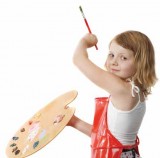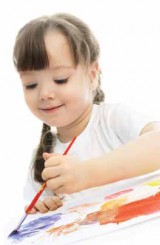Take your first steps towards becoming an outstanding subject leader in art and design with the help of Anne Chowne
If you’re thinking about taking responsibility for art and design leadership, there are two assessments you might make – how strong is your subject knowledge and do you know what and how children have been taught before?
Many primary teachers have not actively engaged in art and design since they were in Y9, and their Initial Teacher Training may not have covered the area in much detail. This means that all teachers need to take some time to enhance their skills.
Staff should all ask themselves: when was the last time I studied art and design? How long is it since I audited my subject knowledge? What hobbies and skills do I have that might be useful in teaching these areas?
As subject leader, you will need to work with colleagues on writing an art and design policy and curriculum development plan. This can sound intimidating, but it really isn’t. Before you start, try asking your colleagues to write down what creative activities they do themselves, and the kinds of things they like looking at. Do they have a hobby such as knitting or a pastime such as watching Artificial Eye films?
Can you illustrate that by looking at fashion magazines or visiting new cities to explore the architecture, they are taking steps towards teaching art and design? Everyone can be a creative practitioner; it’s just a matter of finding the source of your enjoyment and using this in the classroom.
The second consideration will be what prior experiences classes have had of art and design. If there are portfolios of work or sketchbooks in use, you will find it easy to make an appraisal of the level of expertise across media and techniques the children have experienced. If there is no coherent whole school policy or evidence of prior learning then now is the time to get working on them.
 Drawing is to art and design as the alphabet is to language and literacy. It is a human imperative to ‘make your mark’, evident since prehistoric times. But we know that to progress in drawing we need to practice, just as we do when learning how to make pastry or ride a bike. It is up to teachers to provide opportunities, motivation and support for children’s confidence and skill to grow.
Drawing is to art and design as the alphabet is to language and literacy. It is a human imperative to ‘make your mark’, evident since prehistoric times. But we know that to progress in drawing we need to practice, just as we do when learning how to make pastry or ride a bike. It is up to teachers to provide opportunities, motivation and support for children’s confidence and skill to grow.
However, it can be discouraging when you feel inadequate to model mark making to your class. So what to do? You can sign up for an evening class, buy a Drawing for Dummies book, or show the children that there is no right or wrong way to draw. This is what I would advise all primary teachers to do.
Don’t be thwarted by intimidating language used about art, or by uncertainty about what vocabulary to use. There is help at hand! Look up drawing development on learningdesign.com, get The Pictorial World of the Child (Cambridge University Press, 2005) or Teaching Young Children to Draw (Routledge, 1997) out of the library, or research the Campaign for Drawing publications (drawingpower.org.uk).
Teachers should have a sense of what progression in art and design looks like. The National Curriculum in Action section of the QCDA’s website (curriculum.qcda.gov.uk/key-stages-1- and-2/assessment/nc-in-action) has illustrations of art and design projects from Nursery to Y6, with commentary and levels of attainment. While these may not embrace many themes or artistic periods, they do give contexts, learning objectives, photographs of products and an indication of the levels of attainment.
Teachers TV also has some ‘best practice’ videos which give examples of ways of working with children. These are easy to watch at the end of a busy day, and show skilled practitioners questioning children about famous paintings, demonstrating how to build an armature for a bird sculpture, taking pupils on a visit to a sculpture park, and how a school has used the National Gallery’s Take One Picture scheme, amongst others.
The high risk of ‘things going wrong’ when managing an art and design lesson can lead to less confident teachers playing safe. Good practice should encourage risk taking and perseverance, as these are essential life skills. Teachers would do well to learn alongside children, showing aspects of playfulness, trying and testing, being willing to persist and conveying the attitude of being a learner too. Artists don’t necessarily know what the image, object or structure is going to look like before they finish it.
 The portfolio of artists, craftspeople and designers we have access to through the web means that there is no excuse to limit the examples we share with children. Schools can also find funding to employ artists, craftspeople and designers to work with children. These people can bring excitement into the classroom and show young learners that art is something people do for a living. Whether you tap into LONSAS (London Schools Arts Service), or the directories of the Craft or Design Council, collaboration with an artist on a project will reap many rewards, for the teacher and the children. You can look at how these short-term partnerships have been developed (anewdirection.org.uk) and consider whether your school could sign up in the future and get an Artsmark.
The portfolio of artists, craftspeople and designers we have access to through the web means that there is no excuse to limit the examples we share with children. Schools can also find funding to employ artists, craftspeople and designers to work with children. These people can bring excitement into the classroom and show young learners that art is something people do for a living. Whether you tap into LONSAS (London Schools Arts Service), or the directories of the Craft or Design Council, collaboration with an artist on a project will reap many rewards, for the teacher and the children. You can look at how these short-term partnerships have been developed (anewdirection.org.uk) and consider whether your school could sign up in the future and get an Artsmark.
So the main message is – don’t be shy! Use a talent in creating a colourful meal, interior design, choosing jewellery to match an outfit or an interest in classic cars to stimulate the colour, pattern, texture, beauty, and range of enrichment that the Arts provide.
The school community can be a source of inspiration, whether its using the children’s cultural heritage, the enthusiasm of a teaching assistant to share their collection of lace or a parent who loves taking photographs. Anyone can be an artist, it’s just a matter of finding the time to experiment, someone to encourage you, and a mode and medium that liberates you. If you are to be the art and design co-ordinator you need to lead by example. Be brave, make your mark!
Upcoming CPD opportunities with the institute of education…
Art in the maths class – 26 February 2010
This course will focus on shape and space, pattern, scale, ratio, and number in relation to familiar works of art. It will also examine how art processes such as drawing, printing, textiles and the use of sketchbooks can support teaching and learning in art and mathematics. Ref: DC099-10B1
Creative art, sustainable art – 3 March 2010
Learn how to manipulate everyday, throwaway materials in your art lessons; and develop children’s skills by using familiar resource in an unfamiliar way. Ref: DC176-10B1
New ideas for display: A course for teaching assistants – 7 May 2010
A chance for teaching assistants to explore how creative display can be used within the classroom and throughout the school. The course will involve fresh ideas on how to make displaying children’s work interactive. Ref: DC700-10C1
For details on booking, visit ioe.ac.uk or call 020 7612 6000
Boosting children’s self esteem
Ace-Classroom-Support
5 Ways To Celebrate World Book Day
Ace-Classroom-Support
